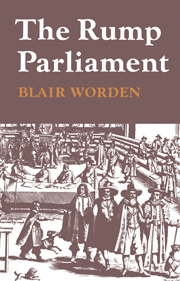Book contents
- Frontmatter
- Contents
- Dedication
- Acknowledgements
- Author's Note
- List of abbreviations
- Introduction
- PART ONE THE RUMP AND THE RUMPERS
- PART TWO THE RUMP AND REFORM
- PART THREE THE STRUGGLE FOR SURVIVAL, FEBRUARY 1649–SEPTEMBER 1651
- PART FOUR PARLIAMENT versus THE ARMY, SEPTEMBER 1651–APRIL 1653
- 13 Reform and reaction, September 1651–May 1652
- 14 Conflict and confrontation, May–December 1652
- 15 Dissolution and disarray, January–April 1653
- PART FIVE THE DISSOLUTION OF THE RUMP
- APPENDICES
- Bibliographical Guide
- Index
13 - Reform and reaction, September 1651–May 1652
Published online by Cambridge University Press: 29 January 2010
- Frontmatter
- Contents
- Dedication
- Acknowledgements
- Author's Note
- List of abbreviations
- Introduction
- PART ONE THE RUMP AND THE RUMPERS
- PART TWO THE RUMP AND REFORM
- PART THREE THE STRUGGLE FOR SURVIVAL, FEBRUARY 1649–SEPTEMBER 1651
- PART FOUR PARLIAMENT versus THE ARMY, SEPTEMBER 1651–APRIL 1653
- 13 Reform and reaction, September 1651–May 1652
- 14 Conflict and confrontation, May–December 1652
- 15 Dissolution and disarray, January–April 1653
- PART FIVE THE DISSOLUTION OF THE RUMP
- APPENDICES
- Bibliographical Guide
- Index
Summary
The triumph of Worcester, ending for the foreseeable future the danger of a successful royalist invasion or uprising, left the army officers free at last to concentrate on problems of social reformation and political settlement. Cromwell and his colleagues were repeatedly to recall the hopes they had entertained of the Rump on their return to London after the battle, and the disappointments which it had held in store for them. Initially, victory produced a glow of goodwill. Hugh Peter urged the militia regiments which had fought at Worcester ‘to think well of the present government who was so watchful for the whole’, and Harrison wrote that God had ‘owned and honoured the House in the eyes of all the world’. Cromwell, now devoting himself principally to civilian politics, came from Worcester to Westminster with three aims in mind. First, he wanted the Rump to dissolve and to hand over power to a new representative. Secondly, he hoped to broaden the base of the Commonwealth's support, principally through an act of oblivion. Thirdly, urging the Rump to ‘encourage and countenance God's people, reform the law, and administer justice impartially’, he called for ‘the fruits of a just and righteous reformation’. Over all three aspects of his programme Cromwell was to be at least partially frustrated.
At first, all went well enough. He received an appropriately heroic reception in London, and was immediately added to the Council of State's most important standing committees.
- Type
- Chapter
- Information
- The Rump Parliament 1648–53 , pp. 265 - 298Publisher: Cambridge University PressPrint publication year: 1974

